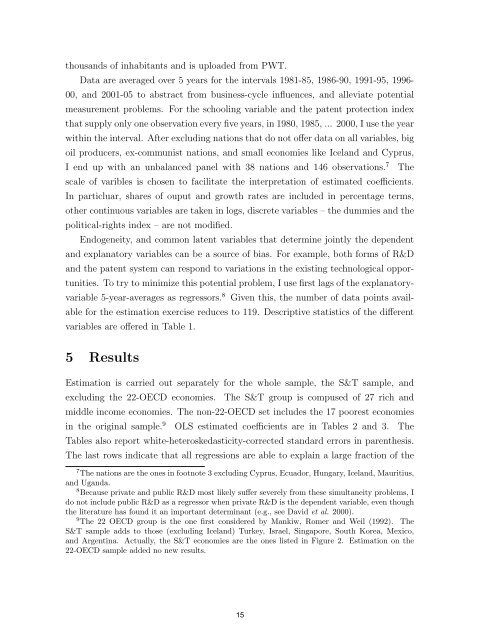Download - Ivie
You also want an ePaper? Increase the reach of your titles
YUMPU automatically turns print PDFs into web optimized ePapers that Google loves.
thousands of inhabitants and is uploaded from PWT.<br />
Data are averaged over 5 years for the intervals 1981-85, 1986-90, 1991-95, 1996-<br />
00, and 2001-05 to abstract from business-cycle influences, and alleviate potential<br />
measurement problems. For the schooling variable and the patent protection index<br />
that supply only one observation every five years, in 1980, 1985, ... 2000, I use the year<br />
within the interval. After excluding nations that do not offer data on all variables, big<br />
oil producers, ex-communist nations, and small economies like Iceland and Cyprus,<br />
I end up with an unbalanced panel with 38 nations and 146 observations. 7<br />
scale of varibles is chosen to facilitate the interpretation of estimated coefficients.<br />
In particluar, shares of ouput and growth rates are included in percentage terms,<br />
other continuous variables are taken in logs, discrete variables – the dummies and the<br />
political-rights index – are not modified.<br />
Endogeneity, and common latent variables that determine jointly the dependent<br />
and explanatory variables can be a source of bias. For example, both forms of R&D<br />
and the patent system can respond to variations in the existing technological opportunities.<br />
To try to minimize this potential problem, I use first lags of the explanatoryvariable<br />
5-year-averages as regressors. 8<br />
The<br />
Given this, the number of data points available<br />
for the estimation exercise reduces to 119. Descriptive statistics of the different<br />
variables are offered in Table 1.<br />
5 Results<br />
Estimation is carried out separately for the whole sample, the S&T sample, and<br />
excluding the 22-OECD economies.<br />
The S&T group is compused of 27 rich and<br />
middle income economies. The non-22-OECD set includes the 17 poorest economies<br />
in the original sample. 9 OLS estimated coefficients are in Tables 2 and 3. The<br />
Tables also report white-heteroskedasticity-corrected standard errors in parenthesis.<br />
The last rows indicate that all regressions are able to explain a large fraction of the<br />
7 The nations are the ones in footnote 3 excluding Cyprus, Ecuador, Hungary, Iceland, Mauritius,<br />
and Uganda.<br />
8 Because private and public R&D most likely suffer severely from these simultaneity problems, I<br />
do not include public R&D as a regressor when private R&D is the dependent variable, even though<br />
the literature has found it an important determinant (e.g., see David et al. 2000).<br />
9 The 22 OECD group is the one first considered by Mankiw, Romer and Weil (1992). The<br />
S&T sample adds to those (excluding Iceland) Turkey, Israel, Singapore, South Korea, Mexico,<br />
and Argentina. Actually, the S&T economies are the ones listed in Figure 2. Estimation on the<br />
22-OECD sample added no new results.<br />
12<br />
15

















